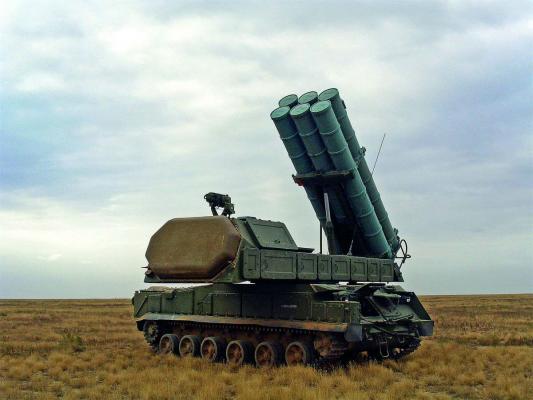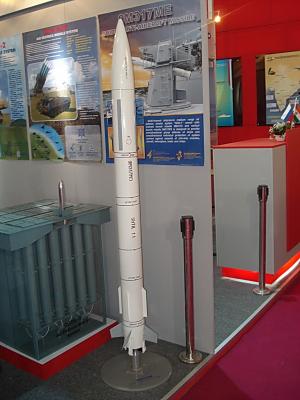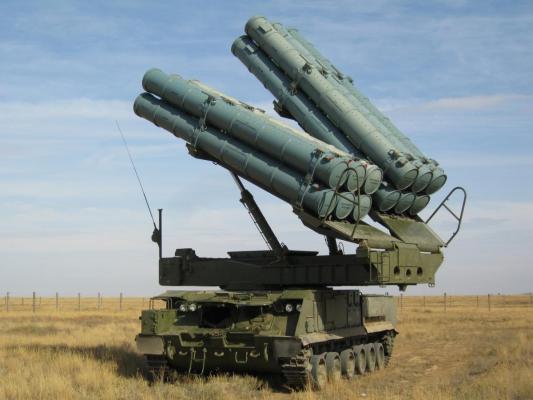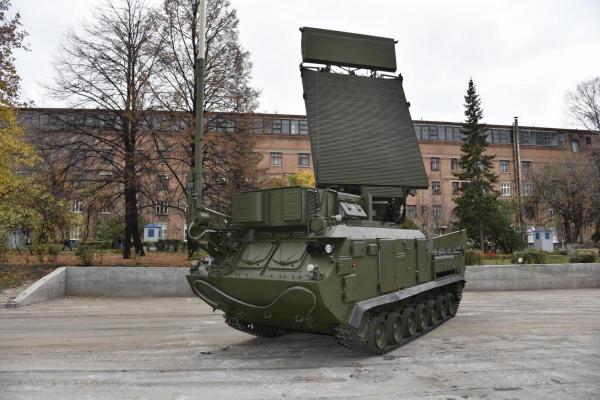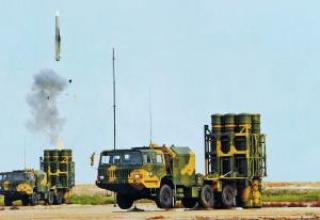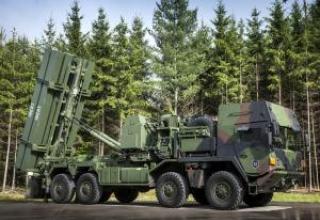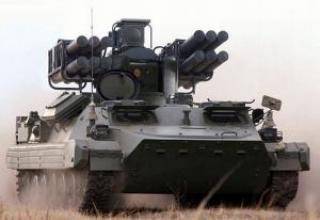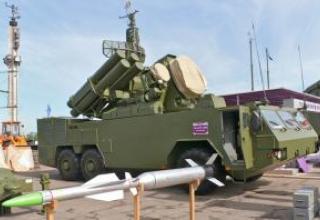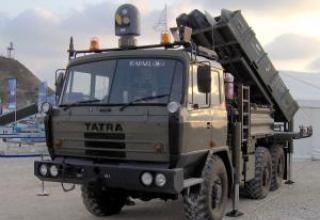9K317M "Buk-M3" (9K37M3) is a medium-range air defense system of ground forces designed to fight maneuvering aerodynamic targets, tactical ballistic missiles, cruise missiles, aircraft missiles and other elements of high-precision weapons, as well as to engage radio-contrast ground and surface targets in the conditions of intensive fire and radio electronic counteraction of the enemy. The complex is designed for year-round, round-the-clock operation in any climatic zones.
The main developer of the complex is the V.V. Research Institute of Instrument Engineering. Tikhomirov Research Institute of Instrument Engineering (JSC "Concern EKO "Almaz-Antey"). The development was carried out under the guidance of Chief Designer E.A.Pigin since 2007. Complex "Buk-M3", having kept the general structure of construction with its predecessor - SAM "Buk-M2", considerably surpasses it in basic tactical and technical characteristics. The 9M317M anti-aircraft guided missile, which is a part of the complex, was created by the Dolgoprudnenskiy Research and Production Enterprise (DRPP) and unified with the missile of sea-based SAM "Stil". The serial production of the complex is organized at the Ulyanovsk Mechanical Plant.
The 9K317M "Buk-M3" complex was adopted in 2016, for the first time it was demonstrated at the International Military and Technical Forum "Army - 2016" in Kubinka (see photo1, photo2). In October 2016, the first division of the Buk-M3 SAM system was supplied to the Russian armed forces.
Composition:
Composition of complex 9K317 "Buk-M3":
- 9C510M combat control station (PBU);
- 9C18M3 target detection radar station;
- up to six 9A317M autonomous self-propelled fire-fighting units (SPS) or 9С36M illumination and pointing radars in any combination;
- up to twelve 9A316M self-propelled launchers (PU);
- transport and charging machines (TZM) 9T243M
Each JMA 9A317M can be assigned one PP 9A316M, tap-changer 9C36M - two PP 9A316M.
Compared to the "Buk-M2" SAM system, the following items have been increased 1.5 times: transportable ammunition, kill zones, number of simultaneously fired targets. Noise immunity and survivability of the complex as well as its performance characteristics have been increased. In full configuration, the complex provides simultaneous firing of up to 36 air targets flying from any direction.
Combat control point 9C510M. The PBU (see photo) ensures the simultaneous processing of information on the air situation based on data from its own target detection equipment and data from the superior command posts and the reconnaissance equipment attached. The number of target designations issued is up to 36. Made on the GM-5969 chassis.
Autonomous SOU 9A317M. In the process of combat work JMA 9A317M provides detection, identification, auto tracking and recognition of the type of target, the development of flight mission, the solution of the launch task, the launch of the rocket, target illumination and the transfer of radiocorrection commands to the missile, the evaluation of the results of firing. The JMA is equipped with: a multi-channel illumination and guidance station, a digital onboard computer, a telecode communication system, a set of launch automation and an arrow for six transport and launch containers with 9M317M anti-aircraft missiles. The installation is made on the unified chassis GM-5969, which has an increased payload and cross-country ability.
The station of illumination and pointing of JMA is similar in design of RPN 9C36M and equipped with phased antenna grating with electronic scanning of the beam. The working range of the station is up to 120 km on targets with 1-2m2 EPR. Zone of target detection: azimuth - ±45 °, the angle of place to +70 °, after setting the route of targets view sectors increase to ± 60 ° on the azimuth and up to +85 ° on the angle of place. SOU 9A317M is capable of independently or according to data obtained from the PBU 9C510M, hitting up to six targets simultaneously.
To increase the interference immunity of the complex in the conditions of counteraction by means of radio electronic warfare of the enemy, the fire control system of SAU 9A317M includes a round-the-clock optical-electronic complex based on sub-matrix thermal imaging and CCD TV channels.
Anti-aircraft guided missile 9M317M. For the complex "Buk-M3" developed a new missile 9M317M, which differs from 9M317 of the "Buk-M2" longer range and speed, increased performance on the interception of cruise and tactical ballistic missiles (see diagram). At the same time, the possibility of using 9M317 missiles with the use of 9A316 missile launchers from Buk-M2 SAM system is preserved. The export version of the missile was designated 9M317ME.
The 9M317M is a single-stage solid propellant rocket made under the normal aerodynamic scheme. Compared to the 9M317, the new missile is equipped with a more powerful dual-mode engine with extended operating time. Due to this, the range of 9M317M was 70km, the height of the target - 35km, the flight speed - 1550m / s. The intercept range of high-speed air targets was increased to 30 km.
The main stage of the missile flight is inertial-corrected mode, and when approaching the target is carried out homing.
To equip missiles such as 9M317M developed a specialized package of modular design of homing heads:
- Multi-mode Semi Active Doppler Homing Radar Head (SHID) 9E432 with integrated on-board computer. PARGSN 9E432 is capable to function in systems with various structure of signals of illumination and radio correction and is programmed before start under type of the struck target (the plane, the helicopter, ground, surface, low visibility). The use of a semi-active homing system requires the illumination of the 9C36M or 9A317M on-load tap-changer, which limits the range of missiles of this type to the radio horizon.
- Slanets" active radar homing head (ARGSN), developed by OJSC "Moscow Research Institute "Agat". Detection and capture of air targets is performed by a slotted antenna array with monopulse direction finder. ARGSN "Slanets" can receive target designation from virtually any external sources (aircraft DRLOiU, SLBM multi-purpose fighter-interceptor, ground and ship radars with the appropriate information exchange equipment). The energy potential of the ARGSN "Slanets" makes it possible to capture a target with 0.3m2 EPR at a distance of up to 35km.
The use of ARGSN in 9M317MA rockets makes it possible to fire with the on-load tap-changers switched off, including those from natural terrain shelters, which increases the survivability of the division many times. A similar modular package based on the ARGSN 9B-1103M Shayba was developed for early versions of 9M317A missiles included in the Buk-M1-2 and Buk-M2 SAM systems.
The 9M317M rocket is an octaclimatic missile and can be used and deployed at any time of year and day. The missile is delivered and stored in an airtight transport and launch container, fully ready for combat use, and does not require inspection of on-board equipment during the entire set period of operation. The TLC is a cylindrical container hermetically sealed with rigid lids or semi-rigid diaphragms. The TPK protects the missile from the external environment, simplifies transportation and maintenance of the missile, provides increased reliability and combat readiness of the complex.
Launching unit 9A316M. PU 9A316M (see photo1, photo2) is made on the chassis GM-5969 and has two booms to install 12 TPK with missiles.
At work on the combat position to the hydraulic system PU series of hydraulic cylinders are connected, providing the installation of each of the booms with the TPC at the required angle to the horizon. As at each moment of time the hydraulic pump of the installation works on moving only one boom from 6 industrial industrial complexes, loads on the hydraulic system are reduced twice, which allowed to place on the PA 9A316M increased ammunition.
After the launch of all twelve missiles, the PU moves to the maintenance position. The unit is equipped in the following order. The first six containers with missiles are installed on the arrows (three for each arrow) and fixed with special pin clamps. The second six containers are mounted directly on the lower tier containers and are also secured with pins.
The on-load tap-changer 9C36M (see photo1, photo2) with an antenna post rising to a height of 22 m ensures the engagement of targets flying at low and extremely low altitudes, in wooded and rugged terrain. Rising antenna post provides expansion of the radio horizon at extremely low altitudes by almost three times, which allows you to detect cruise missiles flying at an altitude of 5m, at a range of up to 70 km. RPN 9C36M is similar in design to the illumination and pointing station JMA 9A317M.
Target detection radar 9C18M3. The three-axis 9C18M3 centimetre range coherent-pulse radar with electronic beam scanning in the vertical plane is intended for airborne scanning with subsequent data transmission (via telecode line) for processing to 9C510M command post. The radar is mounted on GM-5969 tracked chassis. The antenna type is a phased waveguide slot lattice, azimuth scanning - mechanically, at the angle of the place - electronically. Target detection zone: azimuth - 360°, angle of place - 50°, range - 160 km (EPR = 1-2m2). View period - 4.5-6 sec. The station is automatically protected from interferences by means of instantaneous tuning of frequency pulses and blocking of range intervals. The radar is protected against ground and underlying surface glare or other passive interference by compensating for losses in direction, wind speed and selectivity of real targets.
Characteristics:
| Target range, km | 2,5-70 |
| Target kill altitude, km | 0,015-35 |
| Maximum target speed, m/s | 3000 |
| Number of target channels in the division | 36 |
| ZUR 9M317M | |
| Dimensions, mm: - length - maximum housing diameter - steering wheel range |
5180 360 820 |
| Starter weight, kg | 581 |
| Weight in TIC, kg | 1040 |
| Weight of combat unit, kg | 62 |
| Maximum RMS speed, m/s | 1550 |
| Maximum available overload, g | 24 |
Testing:
05.09.2008 The US Navy conducted the second test of SM-6 surface-to-air missiles with over-the-horizon guidance. The missile intercepted a BQM-74 air target.
01.09.2012 In the course of the test, SM-6 was used to destroy a cruise missile target and receive designation from the JLENS system.
01.03.2013 Raytheon delivered the first SM-6 to the U.S. Navy, assembled at its new assembly and test facility in Huntsville, Alabama.
14.06.2013 The Republic of Korea has decided to begin equipping its Aegis destroyers with SM-6 anti-aircraft missiles from 2016. The decision was adopted within the South Korean government's programme on the creation of a national air and missile defence system (KAMD).
26.08.2013 The U.S. Navy fired two SM-6 anti-aircraft missiles from the USS CG-52 Chancellorsville (Ticonderoga class), which successfully intercepted two BQM-74 air targets that simulated cruise missiles.
18-20.06.2014 The USS DDG-23 John Paul Jones destroyer launched four SM-6 missiles for training purposes. One of these launches was classified as "the furthest aerial target intercept in naval history".
14.08.2014 Successful launch of SM-6 missile against a low-altitude subsonic target flying over land. The missile, launched at the command of the launch vehicle into the intended target area, independently searched and hit the target. It demonstrated the ability of the missile's ARGSN to successfully counteract interference from the underlying surface.
24.10.2014 Successful reflection of simultaneous attack of low-sonic BQM-74E and supersonic GQM-163A targets simulating anti-ship missiles. Both targets were intercepted at low altitude by SM-6 missiles launched from the USS CG-62 Chancellorsville cruiser. The launch vehicle was behind the radio-horizon, intercepted by the USS DDG 102 Sampson destroyer using SM-6 ARGSN capabilities.
28.07.2015 The US Navy successfully tested a modified version of SM-6 Dual I missile capable of intercepting ballistic targets.
18.01.2016 The SM-6 missile, launched from the USS DDG-23 destroyer John Paul Jones, hit a surface target - the decommissioned USS FFG-57 destroyer Reuben James. The test was a demonstration of the U.S. Navy's "distributed power" concept. According to this concept, it is assumed that as part of a networked ship group, some ships detect targets, others accompany them, and others strike them.
07.03.2016 The destroyer USS DDG-23 John Paul Jones successfully intercepted five targets using SM-6 SSDs, updating the maximum range record for an air target, which was set in 2014.
14.09.2016 The SM-6 missile for the first time intercepted a Zagorizon medium-sonic target using a communication channel with an F-35 fighter. The rocket was launched by the USS Desert Ship (LLS 1) launch complex equipped with the AEGIS Baseline system. The task was the last stage in a series of tests of the Naval Integrated Fire Control Counterair Network (NIFC-CA) designed to provide interaction between U.S. Navy ships and various aircraft (such as F-35 fighter aircraft) in a single integrated network. During the tests, the interceptor missile received continuous target designation from the fighter, which ensured the successful interception of the target outside the detection area of the launch complex radar.
14.12.2016 The U.S. Navy, with support from the U.S. Agency for Defense, conducted the first test of the SM-6 Dual I anti-aircraft missile to intercept a target simulating a medium-range ballistic missile. It was launched off the coast of Hawaii from a USS John Paul Jones destroyer (DDG 53) equipped with the Aegis baseline 9.C1 system. Two missiles were fired at the target.
30.08.2017 Two SM-6 Dual I interceptor missiles were launched from the USS John Paul Jones destroyer (DDG 53) against a target that simulated a medium-range ballistic missile. During the test, the target was detected, captured, escorted, and two interceptor missiles were launched. During the test, the Aegis Baseline 9.1 (BMD 5.0CU) Ballistic Missile Defense (BMD) battle control system was used.
Sources:
- АО "Научно-исследовательский институт приборостроения имени В.В. Тихомирова" ЗРК "Бук-М3"
- «Бук-М3» против ATACMS: почему российские ракеты превосходят американский комплекс
- http://nevskii-bastion.ru/buk-m3/
- Бук-М3, самоходный ЗРК
- Стратосферный охотник
- Юрий Белый: «Среди мобильных ЗРК средней дальности равных комплексу «Бук-М3» по боевой эффективности не существует»
- Обновлённые «Торы» и «Буки»: противоракетные мастера живучести для войсковой ПВО

